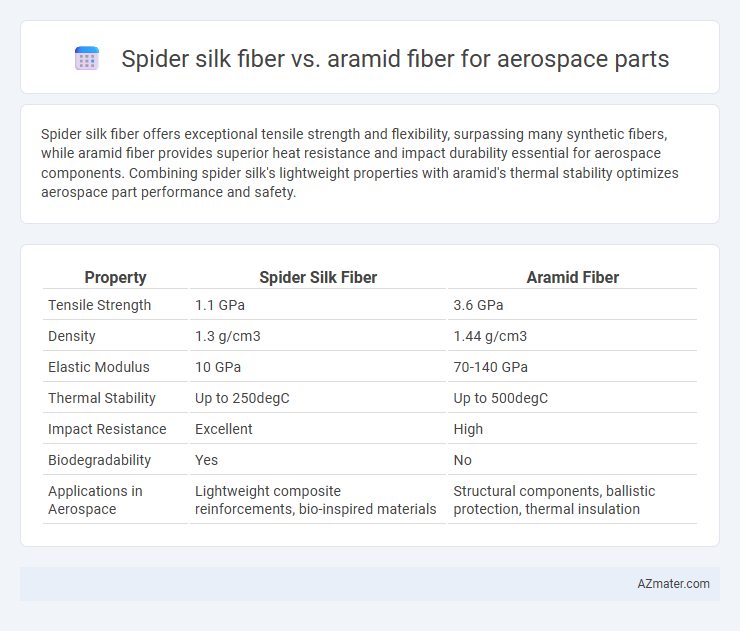Spider silk fiber offers exceptional tensile strength and flexibility, surpassing many synthetic fibers, while aramid fiber provides superior heat resistance and impact durability essential for aerospace components. Combining spider silk's lightweight properties with aramid's thermal stability optimizes aerospace part performance and safety.
Table of Comparison
| Property | Spider Silk Fiber | Aramid Fiber |
|---|---|---|
| Tensile Strength | 1.1 GPa | 3.6 GPa |
| Density | 1.3 g/cm3 | 1.44 g/cm3 |
| Elastic Modulus | 10 GPa | 70-140 GPa |
| Thermal Stability | Up to 250degC | Up to 500degC |
| Impact Resistance | Excellent | High |
| Biodegradability | Yes | No |
| Applications in Aerospace | Lightweight composite reinforcements, bio-inspired materials | Structural components, ballistic protection, thermal insulation |
Introduction to Spider Silk and Aramid Fiber in Aerospace
Spider silk fiber offers exceptional tensile strength, flexibility, and lightweight properties, making it a promising biomaterial for aerospace applications. Aramid fiber, such as Kevlar, is widely used in aerospace parts due to its high strength-to-weight ratio, thermal stability, and resistance to impact and abrasion. Both fibers contribute to enhancing aircraft performance, with spider silk providing improved toughness and aramid fiber ensuring structural integrity under extreme conditions.
Material Composition and Structure Comparison
Spider silk fiber is composed primarily of fibroin proteins arranged in a hierarchical structure with b-sheet nanocrystals, delivering exceptional tensile strength and elasticity. Aramid fibers, such as Kevlar, consist of long chains of poly-paraphenylene terephthalamide polymer with highly oriented, crystalline molecular alignment providing high tensile strength and thermal stability. Compared to aramid fibers, spider silk's unique protein-based composition offers superior toughness and energy absorption, while aramid fibers excel in heat resistance and chemical durability critical for aerospace applications.
Mechanical Properties: Strength and Toughness
Spider silk fiber exhibits exceptional toughness and tensile strength, often outperforming aramid fibers like Kevlar in energy absorption and elasticity under stress. Aramid fibers provide high tensile strength and excellent thermal stability, making them ideal for aerospace components subjected to high temperatures and mechanical loads. The combination of spider silk's superior toughness and aramid's stiffness offers potential for advanced composite materials in aerospace applications requiring both resilience and strength.
Weight and Density Advantages for Aerospace
Spider silk fiber exhibits a significantly lower density of approximately 1.3 g/cm3 compared to aramid fibers like Kevlar, which typically have densities around 1.44 g/cm3. This weight advantage in spider silk translates to reduced overall mass in aerospace components, enhancing fuel efficiency and payload capacity. The superior strength-to-weight ratio of spider silk fibers offers promising potential for lightweight, high-performance aerospace parts where minimizing weight is critical.
Thermal and Chemical Resistance
Spider silk fiber exhibits exceptional thermal stability with decomposition temperatures exceeding 250degC, providing effective resistance to heat in aerospace applications. Aramid fibers, such as Kevlar, demonstrate high thermal resistance up to around 400degC and outstanding chemical resistance against acids and solvents, making them ideal for harsh aerospace environments. The combination of spider silk's unique molecular structure and aramid's proven durability results in a balanced choice for aerospace parts requiring both thermal endurance and chemical stability.
Fabrication and Scalability Challenges
Spider silk fibers exhibit exceptional tensile strength and elasticity, but their fabrication is hindered by complex biological production processes and low scalability due to the difficulty of farming spiders in large quantities. In contrast, aramid fibers like Kevlar benefit from well-established synthetic manufacturing techniques that enable high-volume production with consistent quality, supporting aerospace industry demands. Scalability challenges for spider silk remain significant, limiting its practical application in aerospace parts compared to the readily available aramid fibers.
Cost Analysis: Production and Application
Spider silk fiber offers exceptional strength-to-weight ratios and biodegradability but faces high production costs due to complex harvesting and synthetic spinning processes, limiting its current viability for large-scale aerospace applications. Aramid fiber, such as Kevlar(r), benefits from mature industrial-scale manufacturing, resulting in lower costs per unit mass and widespread use in aerospace components requiring high tensile strength and thermal stability. Cost analysis indicates aramid fibers provide a more economical and scalable solution for aerospace parts, while spider silk remains a premium material with potential for future cost reductions through biotechnological advancements.
Environmental Impact and Sustainability
Spider silk fiber offers superior biodegradability and low environmental impact due to its natural origin and renewable production process, whereas aramid fiber, derived from petroleum-based products, involves energy-intensive manufacturing and generates non-biodegradable waste. The sustainable characteristics of spider silk include efficient carbon sequestration during biosynthesis, minimal chemical use, and reduced greenhouse gas emissions compared to aramid fibers. In aerospace applications, adopting spider silk fiber enhances lifecycle sustainability and aligns with green engineering initiatives aiming to minimize ecological footprints while maintaining high strength-to-weight ratios.
Case Studies: Aerospace Applications
Spider silk fiber exhibits remarkable strength-to-weight ratio and exceptional flexibility, making it a compelling material for aerospace components requiring high durability and impact resistance. Case studies reveal spider silk composites significantly enhance energy absorption and reduce weight compared to traditional materials. Aramid fibers, widely used in aerospace, demonstrate proven thermal stability and mechanical strength crucial for protective gear and structural reinforcements, but spider silk's biocompatibility and environmental sustainability offer novel opportunities for future aerospace innovations.
Future Trends and Innovations in Fiber Technology
Spider silk fiber exhibits exceptional tensile strength, elasticity, and biodegradability, positioning it as a revolutionary material for lightweight aerospace components. Aramid fibers, renowned for their thermal stability and impact resistance, continue to dominate current aerospace applications, but advancements in bioengineered spider silk production aim to surpass these properties while reducing environmental impact. Emerging hybrid composites integrating spider silk with aramid fibers promise enhanced performance, driving future innovations in high-strength, sustainable materials for aerospace engineering.

Infographic: Spider silk fiber vs Aramid fiber for Aerospace part
 azmater.com
azmater.com